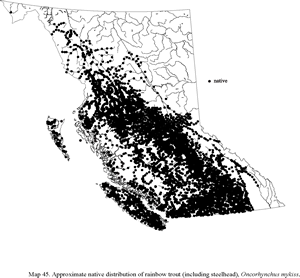The rainbow trout is the most common and popular trout in B.C. In the past, biodiversity in this species has been compromised by fish culture operations but in recent years the emphasis has shifted to protecting the remaining wild stocks. In B.C., rainbow trout occur both as freshwater-resident and anadromous (steelhead) populations. Some authors recognize two subspecies of O. mykiss and both appear to occur in British Columbia — the coastal rainbow trout, O. mykiss irideus and, in the interior, the Columbia redband trout, O. mykiss gairdneri. However, subspecies should represent monophyletic clusters of populations. Consequently, although the coastal and interior forms of rainbow trout generally are treated as two distinct lineages, subspecific names are rarely used. In B.C., recent molecular studies support the notion of two rainbow trout clades. Although the geography of these lineages roughly supports a coastal-interior dichotomy, there is extensive overlap in their distributions. Thus, while many B.C. sites include both lineages, the coastal clade is dominant on the coast and the interior clade is dominant in southern Interior populations. Since the molecular markers characteristic of the two clades occur in both coastal and interior populations, the boundaries between the purported subspecies are fuzzy and confound attempts to assign formal subspecific names to the two clades. Typically, the considerable life history variation in this species (e.g., differences in run-timing, body size, and foraging behaviour) is present in both clades. Nonetheless, some life history types are relatively rare (e.g., large, piscivorous forms) and special efforts should be made to preserve them. Many of the anadromous (steelhead) populations on the south coast are in serious trouble but managers are well aware of the problems.
This is the most common and popular trout in B.C. It has been widely introduced into barren lakes throughout BC. Unfortunately, it has been introduced into the range (areas in the Kootenays) of the westslope cutthroat. The two species hybridize in these areas and there is evidence that the rainbow displaces the westslope cutthroat in some rivers.
Source: Information provided by Don McPhail for E-Fauna BC.
Southwest Atlantic: Argentina (Ref. 9086). Eastern Pacific: Kamchatkan Peninsula and have been recorded from the Commander Islands east of Kamchatka and sporadically in the Sea of Okhotsk as far south as the mouth of the Amur River along the mainland. The records outside of Kamchatka probably represent migrating or straying Kamchatkan steelhead (penshinensis) rather than the established native population (Reg. 50080). One of the most widely introduced fishes, may be regarded as global in its present distribution. In the tropics restricted to areas above 1,200 m. Several countries report adverse ecological impact after introduction (Ref. 5723).
Source:
FishBase. Gall, G.A.E. and P.A. Crandell 1992 The rainbow trout. Aquaculture 100:1-10.
